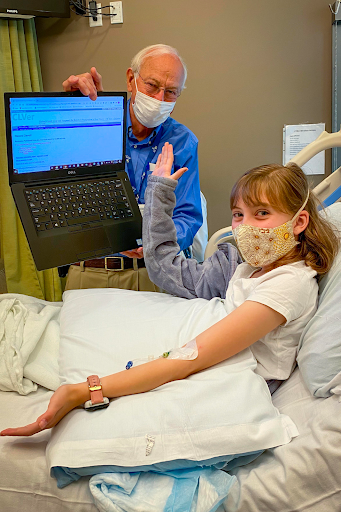A NorCal Teen’s Experience in a T1D Clinical Trial
by Zosia Mosur, 14
I was diagnosed with type 1 diabetes (T1D) over two years ago at the age of 11 and would like to share my experience as a patient in a clinical trial.
For months, unbeknownst to us, I was slowly becoming more and more ill. I had all the symptoms of an undiagnosed person with T1D, all symptoms that my family and I chose to brush off and rename as prepubescence. But when sleeping in longer than 1 hour increments became completely unknown to me and the bathroom was practically my home, we decided that it was time to figure out what was going on.
 Within weeks of being diagnosed and discharged, I was enrolled in a diabetes trial at Stanford University. The trial was specifically for newly diagnosed T1D, and since they had just moved from trials on adults to trials on children, I, eleven years old at the time, was the perfect candidate. The purpose of the trial was to test a drug called Verapamil which was generally used to treat high blood pressure. It’s a low risk and high accessibility drug. The drug was being tested to see if it could be used to elongate the lives of the existing Islet cells when a person is diagnosed with T1D. When someone is first diagnosed with T1D some of their Insulin producing cells, called Islet cells, are still working. This is called the honeymoon phase. The length of this phase is fully dependent on the person. Some people’s last two months while others last two days. Since this trial was blind, I do not know whether I was taking the actual drug or a placebo. However, my family, my doctors, and I suspect that I was taking verapamil, since my blood sugars and time in range compared with my insulin intake show that some of my Islet cells are still alive and at work.
Within weeks of being diagnosed and discharged, I was enrolled in a diabetes trial at Stanford University. The trial was specifically for newly diagnosed T1D, and since they had just moved from trials on adults to trials on children, I, eleven years old at the time, was the perfect candidate. The purpose of the trial was to test a drug called Verapamil which was generally used to treat high blood pressure. It’s a low risk and high accessibility drug. The drug was being tested to see if it could be used to elongate the lives of the existing Islet cells when a person is diagnosed with T1D. When someone is first diagnosed with T1D some of their Insulin producing cells, called Islet cells, are still working. This is called the honeymoon phase. The length of this phase is fully dependent on the person. Some people’s last two months while others last two days. Since this trial was blind, I do not know whether I was taking the actual drug or a placebo. However, my family, my doctors, and I suspect that I was taking verapamil, since my blood sugars and time in range compared with my insulin intake show that some of my Islet cells are still alive and at work.
It has been a little over one year since I finished the trial, and the trial itself lasted about ten months. But my first day of the trial feels like it was yesterday. I was diagnosed in July of 2020, peak COVID times, and during this time everyone was extremely cautious about in-person socializing and everything that falls under that umbrella. Normally, my first day in the trial would have been spread out over two days, but since driving to Stanford campus for two consecutive days would have been twice the work and twice the COVID risk, we decided to pack all of the two days of tasks into one day. We arrived at Stanford at 7am, starting the day off strong with IVs and blood draws of all sorts, taking my height, weight, etc. They got me set up with my Tandem Control IQ pump and a Dexcom G6. And though the day may not have been very lovely, the people in charge of the trial were. I got to be under the care of the incredible endocrinologist, Dr. Bruce Buckingham. And over those next ten months I took one pill every day, and went to Stanford every three months. Those tri-monthly check-ups consisted of blood tests and EKGs, that sort of thing. These visits soon became very enjoyable, as I got to miss school and spend the day with doctors and administrators who soon became friends. Afterwards, all the needles and blood draws would be made up for with a nice meal with my mom and possibly some shopping.
Overall, the trial was an extremely valuable experience for me. Every minute spent with the incredible people running the trial was another lesson learned about my condition.
To any T1D who is eligible for a clinical trial, I strongly encourage you to take advantage of the opportunity. My experience was greatly beneficial, and helped introduce me to the world of diabetes.
There are lots of opportunities to participate in a clinical trial in the Northern California area and beyond as well as remotely. Click here to learn more and sign up.